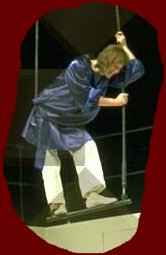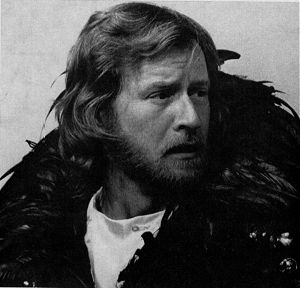|
After the opening, Brook's ideas about the
Dream were widely publicised. These were characteristic: the need to interweave
the actions involving fairies, 'aristocrats' (the lovers apparently included)
and mechanicals; the difficulty of finding stage techniques to create the
play's magic for a materialistic modern audience; a determination that the play
dealt covertly with dark sexual passions; and the propositions that 'the core
of the Dream is the "Pyramus and Thisbe" play' and that 'It's a sort of
celebration of the theatre arts.' 1
A good general description was given by
Rosemary Say, who also raised some of the points around which critical debate
revolved. 'Peter Brook ....... is more determined than ever to compel us to
take a creative part in his production. This time we are to be bullied into
getting our imaginations to work. His method, lively and inventive, just gets
by - particularly when he allows Shakespeare to take some part in the
proceedings from time to time. The stage is white-walled and empty. An iron
gallery runs round the top where those members of the cast not immediately
taking part stand to look down on the play in the manner of overseers
supervising a factory floor. Two trapezes hang on black cords and a vast red
plume is splashed across the back wall. The actors spill on the stage, a garish
mixture dressed in King's Road-type shirt and trousers, white silk cloaks and
dresses of hard primary colours. Last come the artisans, a gang of workmen
carrying planks, sandwiches and mugs of tea.' 2
For others, the set had different assoiations, among them 'circus big top',
'squash court', 'polar bear pit at the zoo', gymnasium, play-room - even the
Elizabethan stage, with its tiring house-wall, two large upstage doors and
gallery above and behind the stage.3
A widely admired feature of the performances
was, once more, clarity: 'Never have I heard the verse more beautifully spoken,
every line comes across as if the thought behind it had just been born in the
actor's mind.'4 Even a tendency for verse,
especially that of the lovers, to modulate into song provoked little strong
dissent. Clarity was also the key to the fairies and the magic flower. No
illusion was allowed, the means of the fairies' teasing of the mortals were as
visible as the devices of 'Pyramus and Thisbe'. The programme quoted from
The Empty Space: 'It is up to us to capture [the audience's] attention
and compel its belief. To do so we must prove that there will be no trickery,
nothing hidden. We must open our empty hands and show that really there is
nothing up our sleeves. Only then can we begin ' (pp. 108-9). A circus trick
represented the magic flower: a spinning plate was passed from wand to wand by
Puck and Oberon (and sometimes dropped\0 as they swung on the trapezes. The
nearly continuous musical background was carefully orchestrated. The whole
cubic space of the stage was filled , by action on the trapezes; by the
hoisting up of Titania's feather-bed; by Puck on high stilts misleading
Lysander and Demetrius; by the metallic coil 'trees' dangled on fishing-rods
from the gallery by the fairies; and by the athletic running, jumping and
climbing of the lovers. The lovers were denied lyricism, almost becoming the
knock-about comics of the play. Hermia in particular was constantly in motion,
being caught horizontally across doorways or snatched up by trapeze,
indignantly crying 'Puppet!'. A still centre was afforded by the solemnity with
which the mechanicals set about rehearsing their play. In performance, its
effect was to provoke in the courtly audience not with laughter but a hushed
involvement. Titania's encounter with Bottom, the climax before the interval,
was remarkable for the physicality of her lustful assault and culminated in a
triumphant and ithyphallic hymeneal procession, to the accompaniment of flying
streamers and Mendelssohn's wedding march, while Oberon swung wildly above on
his trapeze.
The allusion to Mendelssohn pinpointed the
iconoclasm of the production. Not only was an older stage tradition left far
behind but, for at least one reviewer, Shakespeare's text too. John Russell
Brown 5 spelt out, in acid tones, the exact
degree and detail of infidelity into which Brook's pursuit of that 'hidden
play' so 'very powerfully sexual' had led him, demolishing point by point
Brook's most extreme allegation about Oberon - that Shakespeare's King of
Fairies is to be seen as 'a man taking the wife whom he loves totally and
having her f******* by the crudest sex machine he can find'. 6 |

